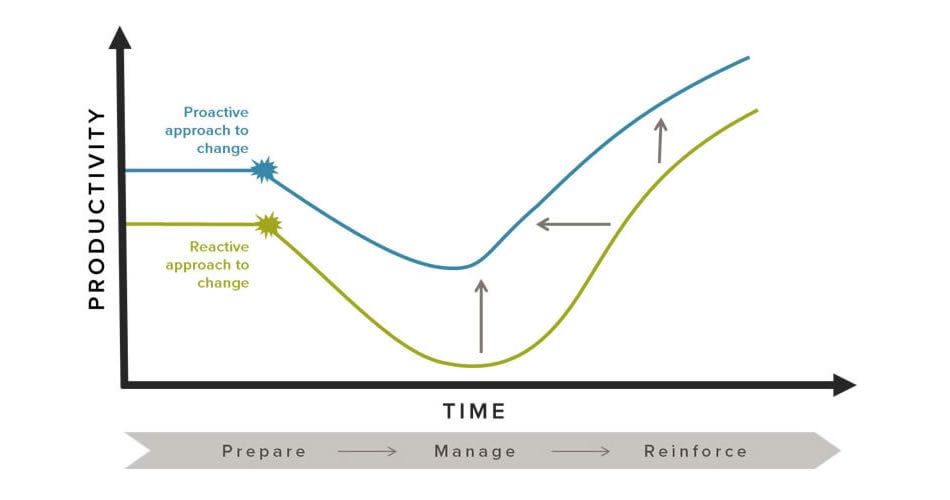Planning for the Inevitable: A Proactive Change Approach

Organizations seek change for many reasons—from adapting to changing business conditions or entering new markets, to gaining operational efficiencies. Whether it’s as simple as a new contract process or as radical as a new business model, landing change effectively and speedily is what separates successful organizations from the rest of the pack.
Effective and speedy change doesn’t just happen by accident. It happens as the result of a thoughtful, proactive effort. Bridge Partners has helped many organizations land successful change initiatives and maximize the benefits of those initiatives using a structured change management approach. Framed by three objectives common to all change management efforts, we seek to:
1. Decrease the dip in performance
2. Shorten the duration of the dip in performance
3. Increase the gains realized from change

Decrease the dip in performance
Studies show that with change management projects, there is an inevitable dip in productivity. Impacted individuals contribute to this dip by the way they respond to change. The typical responses include:
- Denial – Believing that the impact of change is not applicable to them or their team ?
- Resistance – Continuing to operate “business-as-usual” or actively fighting change
- Exploration – Challenging new ways of doing business by comparing them to the old ways or looking for personal benefit
- Lack of Commitment – Not fully buying in and seeing how change benefits them and the organization
A fundamental component of change management is helping individuals see the benefits of change and identify and overcome the barriers they experience. It is critical to secure an executive sponsor to articulate the case for change. And that sponsor must be committed to the change themselves and have the credibility and rapport to get the organization aligned and individuals committed.
Shorten the duration of the dip in performance
To shorten the dip in performance, it is key to conduct a thoughtful examination of existing processes and a thorough impact assessment. Some common areas to explore during the impact assessment are:
- Scope – Determining the amount of change and the span of people, processes, and technologies affected
- As-Is/To-be Comparison – Identifying the major differences between the current state and the new state
- Risk Mitigation – Planning to address pitfalls and drawbacks during the change effort
The next step is to create a plan that mitigates the process impacts and delivers the future state in a measured way.
Increase the gains realized from change
To increase the momentum of change, organizations should celebrate commitment and look for ways to continuously improve. Communicating successes and implementing a plan to measure the effectiveness of change can help them improve further and build positive momentum. Areas that are frequently neglected are:
- Measurement – Measuring the adoption and results attributed to the change
- Incentives – Ensuring impacted organizations and individuals are motivated to change
- Readiness – Identifying training and organizational alignment needed to enable and prepare people for change
In today’s environment, where technology changes rapidly and new markets emerge daily, reactive change is not enough. When change is too slow, too incremental, or, conversely, too big, it can paralyze organizations of all shapes and sizes. When that is the case, the costs often outweigh the benefits. To grow and adapt, successful organizations must practice intentional, proactive change.
About the author



